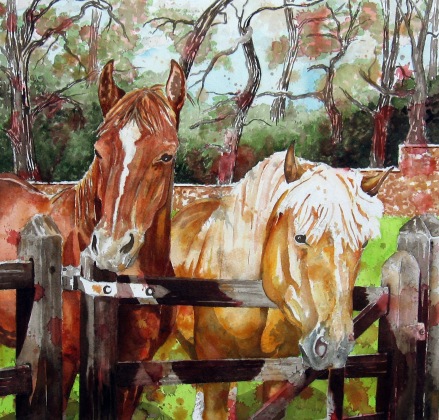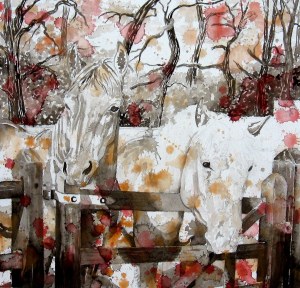STEP 1 : Monochromatic Study
STEP 2 : Splatter
STEP 3 : Lift and Soften Edges of Some Splatters and Add Color
The above two paintings are Nancy”s and my final attempts with working together on splatter painting. We completed five paintings, each, experimenting with subject material and color. We practiced and painted a grisaille, first, in all five paintings. We used this technique to paint buildings, portraiture, city scenes and landscape.
I have learned that it is very difficult to ruin a watercolor and that it is harder to get mud than I thought. I learned I could paint a monochromatic study and still return to vibrant color. The splatter helped to create interest and enhance depth in some of them. We called them our dirty paintings because we had to get used to the way they looked following the splattering phase. I think the splatter helped the “look” of what I normally paint just like the masa paper and citra-solv collage helps my paintings.





28 Comments
You’ve been in some grays, too. Horses are fantastic! I recently got watercolor paints made in St. Petersburgh, they contain mostly natural pigments (at least that’s what is believed), and it seems to me so far they would not create mud with any color. I tried to mix on paper all kinds of them, and nothing turned into mud! Your paintings don’t even distantly make one think about this issue!
I was really impressed with your gray paintings, Inese. They glow! I have some cake watercolors a student brought to me from St. Petersburgh and I found the same thing to be true with those. They are strong and vibrant. I think the only way one gets into trouble with watercolor is when their paper gets too wet and they keep trying to layer before the first layer dries. The paper gets saturated and tired is how I describe it. Thank you for your insights and comments! 🙂
I am blown away by Nancy’s piece; like visiting an old home for sale! Those splatters worked beautifully in this piece. As always, your horses and colors are just gorgeous, Leslie! I so could live in the ranch belonging to these horses. My kind of place!!!
Isn’t that bathroom interior fascinating with the light from the window, Sherry! Thank you for your comments on both of these!
Bravo! You are an investigator and you always come up with a new kind of painting. This would make you the great teacher that you are. These paintings are beautiful.
Thank you, Gretchen. You hit the nail on the head. I often wonder if I would still paint if I didn’t try new things. I agree, totally, with your choice of the word investigator. Thank you for that.
Fascinating! Almost enough to make me want to try watercolors again!! 🙂
Thank you, thank you, Susan. Your statement brings to mind my attempts at working in acrylics. I am horrible with them. You are great with them! I admire artists that can create, effectively in several mediums.
Lovely. I always enjoy reading about techniques you try. By the way, your lovely painting is up in my office at school.
Thank you, Yousei! Oh, I love that you hung it in your office! Good fortune on this next step in your journey. You have worked so hard toward this goal!
Convey my Congratulations to Nancy, this final work of the series is a spot on! The technique suits the subject so well and made it very authentic. And, your horses have always amazed me, you bring out a certain character in them just like a human portrait, the total effect from the process looks beautiful!
I am sure that Nancy has already read your praise for her painting, Padmaja. I know she thanks you. I love painting horses. I guess if we were in a world where I had to select one thing and only paint that one thing, over and over again, I’d choose the horse. So, I thank you for remembering those other horse portraits.
I really am learning a lot from your posts. Thank You!!
Thank you, Marian. I so enjoy sharing ideas and also getting ideas from others.
Leslie and Nancy….I don’t even know what to say anymore. You took this technique and just went wild.
Nancy, I love, love, love your room. It reminds me of some of the tenement buildings I’ve seen. I think my grandfather lived in one in Manhattan many years ago. You did a fantastic job.
Leslie, Your horses are outstanding. I really loved the grisaille you did. It reminded me of a snowy day with white horses and I think it could have stood on its own. But your finished piece is gorgeous. I like the metal hinge on the gate and how you saved some of the white from that.
Beautiful work. I better get crackin’ on my paintings. I have one I’m working on now. You both are an inspiration!
Oh my gosh, we thank you for introducing this to us. Who would have thought we’d turn this into an entire summer project! You mention the grisaille could have stood on its own. Believe me. That was exactly something Nancy and I talked about with this one, but I pushed on through that desire and glad I did. Now we know this technique can be used for portraiture, also. Thank you for all you said, here, Carol.
This technique is so darn effective, it makes me want to abandon my clunky oil pastels and take up watercolors. Both paintings are really fantastic pieces!
Oh don’t do that! I so tried oil pastels and could not get them to do what I wanted them to, Mary. You are soooo good with them! But thank you for such a great comment! Made me feel good. 🙂
Horses! Woo! The face on that left one in particular is so great! Sounds like you learned so much in these five paintings. 🙂
I know! You are doing horses, too! I have been so fascinated with the characters you create with them! Thank you, Cindy! 🙂
I like these. I think it is almost impossible to ruin a painting. That is what makes the expression and personal voice part so important.. These paintings are great.
You are living proof, with your art, that a painting can’t be ruined, Sam. Thank you for taking time to comment and to mention the splatter paintings we have been working on on your blog.
I agree with all the comments, these paintings are breathtakingly beautiful and make me want to try watercolours again! Thank you for your interesting and informative blog!
Thank you, so much, cadpaint, for re-visiting my blog. Awesome work you are doing with your pet portraiture! http://veteranpetportraits.wordpress.com/
That bathroom looks wonderfully dirty – I love it! Do you think you’ll continue to paint in this way now? or try and incorporate some of the technique into your usual way of painting? I still need to find the time to give this a try.
Oh yes, I will paint this way again, for sure. I won’t exclusively paint this way, however. I look at splattering as a technique I can keep in my back pocket to pull out when the situation arises where it may enhance some subject I am painting. I enjoy so many things, the citra solv collage, the masa paper painting, switching the brands of watercolor paper I use. What I did learn is how flexible we, as water colorists, can be when we paint what we see. …and that it is very hard to ruin something. There is always something at hand that we can try if we expose ourselves to techniques and other possibilities. Excellent question, Nicola, and I thank you for that! 🙂
Oh! I love that bathtub room! I can just feel it! And Leslie, I think your final horses are stunning, but I also LOVE the previous stage with the splatters!! This looks like such fun, I’m going to try it !!
Do try it, Isabelle. It is quite a lengthy process but well worth the time. It brings something new to the scene each time. Thank you!